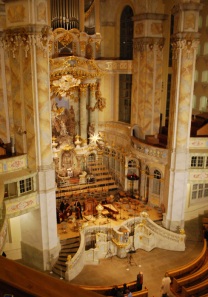Tags
acoustics, aria, cantata, chorale, Christmas, Christmas Oratorio, Dresden, emotions, Frauenkirche, Handel, horn, Markus Brutscher, Messiah, microphone, oboe, oboe d'amore, oboe da caccia, recitative, soprano, tenor, trumpet
 While selections from Handel’s Messiah are nearly ubiquitous in North America at Christmastime, performances of Handel’s oratorio of 1741 are infrequent during the Christmas season in locales where German is the predominate language. For the most part, German-speaking audiences reserve Messiah for Lent and attend performances of Bach’s Christmas Oratorio (BWV 248) during Advent and the twelve days of Christmas.
While selections from Handel’s Messiah are nearly ubiquitous in North America at Christmastime, performances of Handel’s oratorio of 1741 are infrequent during the Christmas season in locales where German is the predominate language. For the most part, German-speaking audiences reserve Messiah for Lent and attend performances of Bach’s Christmas Oratorio (BWV 248) during Advent and the twelve days of Christmas.
A performance of the Christmas Oratorio on 2 December 2011 at the Frauenkirche in Dresden illustrated the advantage of mounting Bach’s entire work in a single performance. While the six parts of the oratorio were originally crafted to function as a series of individual cantatas to be performed over the course of the 1734-5 Christmas season, the three-hour Dresden performance was able to combine all six of the cantatas into a single arch of color and emotion that not only succeeded in preserving the sentiment unique to each cantata but also conveyed the balance and strength of Bach’s great construction.
 The Kammerchor der Frauenkirche, along with tenor Markus Brutscher and the Ensemble Frauenkirche, were primarily responsible for this success. Under the direction of Matthias Grünert, the sound of the semi-professional chamber chorus, founded to celebrate the consecration of the reconstructed Frauenkirche in 2005, soared throughout the resonant church, tingling spines whenever the female sopranos chimed the melody of a chorale. In contrast to his narrative style as the Evangelist, Brutscher animated his arias and selected recitatives with great feeling. Yet, while the trumpeters and hornists flawlessly executed their passages of stratospheric brilliance, it was the two oboists who were the most impressive instrumentalists of all. Occasionally trading their regular instruments for more gently-voiced oboes d’amore and oboes da caccia with non-playing assistants, whose responsibility it was to keep all the instruments warm and in tune, this masterful pair proceeded to spin gorgeous countermelodies among the lines of the four vocal soloists throughout the evening.
The Kammerchor der Frauenkirche, along with tenor Markus Brutscher and the Ensemble Frauenkirche, were primarily responsible for this success. Under the direction of Matthias Grünert, the sound of the semi-professional chamber chorus, founded to celebrate the consecration of the reconstructed Frauenkirche in 2005, soared throughout the resonant church, tingling spines whenever the female sopranos chimed the melody of a chorale. In contrast to his narrative style as the Evangelist, Brutscher animated his arias and selected recitatives with great feeling. Yet, while the trumpeters and hornists flawlessly executed their passages of stratospheric brilliance, it was the two oboists who were the most impressive instrumentalists of all. Occasionally trading their regular instruments for more gently-voiced oboes d’amore and oboes da caccia with non-playing assistants, whose responsibility it was to keep all the instruments warm and in tune, this masterful pair proceeded to spin gorgeous countermelodies among the lines of the four vocal soloists throughout the evening.
But the extraordinary excitement of this Christmas Oratorio performance may have been due as much to the behavior of the audience as to the perfection of the performers. Alerted by the onstage forest of microphone stands and a printed notice in the program that this performance was being recorded for commercial release, the Dresden audience sat in rapt attention and refused to breathe until the final chord’s last wisps of sound, floating upward into the distant heights of the church’s central dome, had disappeared into complete silence.

The Frauenkirche in Dresden made this a performance to remember.
Pingback: Christmas in June «
Pingback: Bach Ousts Seasonal Schmaltz | Boulder Bach Beat